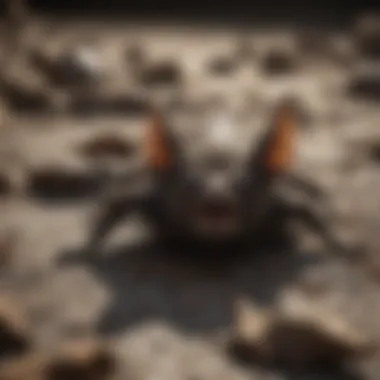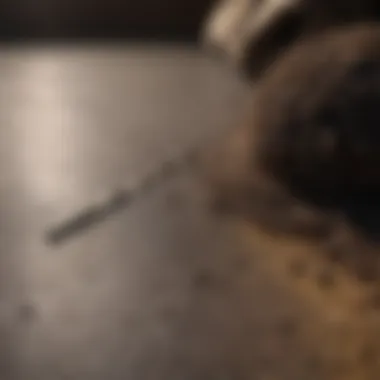Cleaning Bat Poop: An In-Depth Guide to Safety and Effectiveness


Intro
Bat guano is not just a nuisance; it poses significant health risks and can lead to extensive property damage if left untreated. Understanding the nature of bat droppings and the implications for health and safety is essential for homeowners, pest control professionals, and enthusiasts alike. This guide provides a thorough exploration of methods for safely cleaning bat guano, the equipment required, and the preventive measures that can be taken to maintain a clean environment.
Bat populations are often misunderstood. While they play an important role in ecosystems, their presence in residential or commercial spaces can have repercussions. From histoplasmosis—a fungal illness linked to bat droppings—to potential structural damage from the accumulation of guano, the need for effective management is clear.
Understanding Pests
Definition of Pests
In the context of this article, pests refer to any unwanted animals or insects that invade human habitats. Bats, while beneficial as natural pest controllers, may become a headache when they decide to roost near or in our living spaces. Their droppings, known as guano, can accumulate quickly, leading to sanitary issues.
Importance of Pest Identification
Identifying bats and their droppings is the first step in effective management. Not all species of bats pose the same risk. Conducting a thorough inspection helps to determine the extent of the infestation and informs the cleaning approach required. Recognizing their droppings, which are often brown, crumbly, and resemble mouse droppings, assists in confirming their presence in your environment.
Prevention Techniques
Home and Garden Preventative Measures
Taking steps to prevent bats from nesting near your property is fundamental. Here are several actionable strategies:
- Seal Entry Points: Inspect your home for openings and gaps that might allow bats to enter. This includes checking vents, chimneys, and any cracks in walls or foundations.
- Landscape Wisely: Maintain gardens and yards to deter bats. Avoid having dense vegetation that provides shelter.
- Remove Food Sources: Ensure that areas around your home do not attract insects, which serve as food for bats. Regular yard clean-ups can help.
Seasonal Prevention Tips
Different seasons bring unique challenges. In warm months, bats search for roosting spots. During this time, it's wise to increase vigilance:
- Spring to Summer: Keep windows and doors screened, and monitor outdoor lighting that could attract insects.
- Autumn: Check for potential nesting sites. As bats seek shelter for winter, now is the time to address any vulnerabilities.
Eco-Friendly Pest Control Solutions
Overview of Sustainable Practices
For those who prioritize environmentally friendly solutions, eco-aware pest control practices are crucial. Refraining from chemical pesticides minimizes harm to wildlife and preserves ecosystem balance. Utilizing bat houses can encourage bats to roost in controlled locations rather than in undesirable areas.
Natural Remedies and Their Effectiveness
While cleaning bat guano requires some diligence, natural cleaning agents can effectively manage this problem.
- Vinegar: A solution of vinegar and water can help disinfect areas contaminated with droppings.
- Baking Soda: This can be sprinkled on droppings to neutralize odors before cleaning.
"Understanding and managing bats responsibly ensures a balance between health safety and ecological benefits."
This guide sets the groundwork for comprehending the implications of bat guano and presents solutions that prioritize safety and environmental responsibility. Through understanding the unique nature of bats, employing preventive measures, and seeking eco-friendly cleaning solutions, individuals can effectively maintain a safe and clean living environment.
Foreword to Bat Guano
The presence of bat guano carries various implications that need careful consideration. Understanding what bat guano is and why it is significant is essential for homeowners and property managers. Bat droppings are not merely waste; they can create health risks and structural damage if not handled correctly.
What is Bat Poop?
Bat poop, or guano, consists of the droppings of bats. These droppings typically accumulate in areas where bats roost, such as attics, eaves, or secluded spaces. Guano is usually dark, crumbly, and often has a strong odor. The composition of bat poop includes partially digested insect remains and can present a variety of risks when it comes into contact with humans or pets.
From a biological standpoint, bat guano is rich in nutrients and can be an excellent fertilizer; however, it poses potential health risks. Exposure to bat droppings can lead to serious illnesses, such as histoplasmosis, a respiratory illness caused by a fungus that thrives in bat droppings when spores become airborne.


The Importance of Cleaning Bat Guano
Cleaning bat guano is not only crucial for health reasons but also for maintaining property integrity. Accumulated droppings can degrade structures, lead to unpleasant odors, and attract pests. Hence, it becomes imperative to remove these droppings effectively.
Regular cleaning can safeguard against these issues, fostering a healthier environment and preventing necessary repairs down the line. Without adequate cleaning protocol in place, the health hazards posed by bat guano can escalate, making it essential for homeowners to understand the appropriate methods and protective measures needed during cleanup.
In summary, recognizing the properties of bat poop and emphasizing the need for diligent cleaning procedures can significantly impact managing bat infestations. Thus, establishing a set of guidelines and strategies for addressing bat guano concerns is fundamental in this context.
Understanding the Risks Involved
The presence of bat guano introduces various hazards that merit careful consideration. Understanding these risks is essential to safeguard both health and environmental integrity. This section outlines the primary health concerns and environmental implications associated with bat droppings. This knowledge aids in crafting effective cleaning and management strategies.
Health Hazards Associated with Bat Guano
Bat guano is not merely a nuisance; it carries significant health risks. One main concern is histoplasmosis, a respiratory illness caused by a fungus that can grow in bat droppings. When disturbed, spores can become airborne, leading to serious respiratory issues for those who breathe them in. Symptoms can range from mild flu-like feelings to severe chronic lung problems, requiring careful attention during cleanup.
Another health risk involves various parasites found in bat feces, including roundworms and other pathogens. These can pose additional dangers when cleaned improperly or when contaminated surfaces are touched without adequate sanitization.
It is crucial to maintain awareness of these potential hazards by following proper protective measures and ensuring thorough cleaning. The use of appropriate gear, such as masks and gloves, is necessary to minimize exposure. Moreover, individuals should be informed about the signs of product contamination and act swiftly to address any issues. By understanding these health hazards, individuals can prevent serious health ramifications for themselves and their communities.
Environmental Impact of Bat Droppings
Beyond human health, bat guano presents certain environmental concerns. Large accumulations can promote the growth of fungi, leading to broader ecological implications. These changes may disturb local ecosystems, affecting flora and fauna reliant on a balanced environment.
Additionally, bat guano contributes to nutrient loading in surrounding areas. This can result in increased nitrogen levels in soil and water systems, potentially causing algal blooms and other toxic outcomes within local waters. Such conditions may endanger aquatic life and can lead to broader environmental challenges.
Understanding these environmental impacts is essential for homeowners and pest control professionals. Proper and prompt cleanup can alleviate many of these concerns. As an environmentally conscious society, it is crucial we address these impacts while ensuring safety for both habitants and the surrounding ecosystem.
"The awareness of both health and environmental risks associated with bat guano is vital for successful management and cleanup efforts."
This knowledge underscores the importance of maintaining clean, safe, and balanced environments for all.
Preparing for Cleanup
Before diving into the cleaning process of bat guano, it's crucial to understand the preparation required. Proper preparation not only safeguards health but also improves the efficiency of the cleanup task. A strategy that includes the right equipment and protective measures can greatly reduce risks involved in handling bat droppings. This section highlights essential elements to consider, focusing on the significance of protective gear and the necessary tools needed for a thorough cleanup.
Essential Protective Gear
When dealing with bat poop, or guano, the importance of wearing protective gear cannot be overstated. This material can harbor various pathogens, which pose significant health risks to humans. Below are the critical pieces of protective gear you should consider:
- N95 Respirator: This mask filters out airborne particles and offers protection against inhaling harmful spores and pathogens.
- Gloves: Disposable gloves, ideally made of latex or nitrile, can prevent direct contact with hazardous materials.
- Protective Clothing: Long-sleeve shirts and pants should cover the body to limit skin exposure. Wearing clothing that can be easily disposed of or washed is recommended.
- Safety Goggles: These protect the eyes from dust and possibly harmful substances.
Using appropriate protective gear minimizes health risks and establishes a safe environment for conducting cleanup procedures.
Tools and Equipment Needed
A well-planned approach to cleanup necessitates specific tools and equipment. Utilizing the right tools enhances effectiveness while safeguarding the individual involved in the cleaning. Here’s a list of essential items to consider:
- Trash Bags: Heavy-duty trash bags are necessary for disposing of collected guano and contaminated materials.
- Shovel or Scoop: A scoop facilitates the collection of larger debris without needing to touch it directly.
- Broom and Dustpan: For gathering smaller particles, a broom and dustpan are efficient.
- Disinfectants: A reliable disinfectant, such as a bleach solution, is needed to sanitize the area post-cleanup.
- Spray Bottles: For applying disinfectants or cleaning solutions effectively.
- Vacuum Cleaner with HEPA Filter: A vacuum equipped with a HEPA filter captures fine particles like guano dust without releasing them back into the air.
Equipping yourself with the correct tools ensures the cleanup process is smooth. It allows for immediate and effective handling of the bat guano while minimizing risks to your health and safety.
Step-by-Step Cleaning Process
Cleaning bat guano is a detailed process that requires careful attention to ensure safety and effectiveness. This section will outline the steps necessary for proper cleanup. Each part of the cleaning process serves a purpose to minimize health risks, protect the environment, and ensure that the area is restored to its original condition. By following a structured method, homeowners can address the issue more efficiently.
Initial Assessment of the Area


Before starting any cleanup, an initial assessment is crucial. This involves examining the extent of the bat guano accumulation. Look for areas with significant droppings or noticeable stains. Identifying the amount of waste helps determine the necessary tools and personal protective equipment. It is also wise to check for any signs of bats, such as nesting materials or entry points. This assessment should be conducted carefully to avoid disturbing any bats that may still inhabit the area.
Removing Loose Debris
After assessing the area, the next step is to remove any loose debris. This might include trash, leaves, or other materials that could interfere with the cleaning process. It is essential to use a broom or vacuum specifically designed for heavy-duty work. Avoid using a regular household vacuum, as this can aerosolize harmful particles. Instead, consider a HEPA vacuum to contain potential contaminants. Ensure that you wear gloves during this task to protect your hands from irritants or bacteria that may be present.
Safe Handling of Bat Guano
Handling bat guano requires specific precautions. Wear protective gear, including gloves, a mask, and goggles. Bat droppings can release spores that cause histoplasmosis, a serious respiratory disease. If possible, use a damp cloth or spray the droppings with water to prevent dust from being stirred up. Carefully scoop up the waste using a disposable container. Ensure that the guano is sealed tightly before disposal. It is also important to handle this task in a well-ventilated area to reduce the risk of inhalation.
Disinfecting the Area
Disinfection is a key part of the cleaning process. After removing the droppings, the area should be disinfected thoroughly to eliminate any pathogens. A solution of bleach and water or commercial disinfectants can be used. Mix one part bleach with ten parts water for effective disinfection. Apply this solution to surfaces where guano was present. Allow it to sit for at least 10 minutes before wiping it clean. Make sure to follow all safety guidelines while using cleaning agents. Open windows and wear a mask to avoid fumes.
Remember: Proper cleaning and disinfection are essential to prevent health issues associated with bat guano. Each step plays a vital role in delivering a safe environment.
Following these steps correctly can significantly decrease the risks posed by bat droppings and restore safety in your home or property.
Post-Cleanup Procedures
After the meticulous cleanup of bat guano, certain procedures are essential to ensure safety and effectiveness. Neglecting these steps may lead to lingering health risks or environmental issues. This section focuses on post-cleanup tasks that reinforce a safe and clean environment while emphasizing the correct handling of materials and personal hygiene practices.
Proper Disposal Methods
Proper disposal of bat guano is critical to minimize health risks and environmental contamination. First, it is important to check local regulations regarding hazardous waste. Depending on the municipality, bat droppings may require specific disposal methods. Here are some recommended steps for disposal:
- Seal in Plastic Bags: Collect all bat guano and contaminated materials in sturdy plastic bags. Make sure to double bag to avoid any leakage.
- Label the Bags: Clearly label the bags as "Biological Waste" or "Animal Waste" to inform others handling the waste.
- Identify Disposal Sites: Research local disposal sites that accept biological waste. Some areas have dedicated facilities for hazardous waste.
- Follow Health Guidelines: Adhere to health department guidelines to ensure safe entry and disposal of guano. Do not leave these materials in regular trash bins.
Taking these disposal methods seriously can significantly reduce the chance of disease spread and protect the local ecosystem.
Decontaminating Equipment
Ensuring that all tools and equipment used during the cleanup are properly sanitized is fundamental. Contaminated equipment can pose health risks not only to the individual who cleaned but also to others in the vicinity. Here are steps to effectively decontaminate your tools:
- Use Protective Gloves: Always wear gloves while cleaning equipment. This prevents direct contact with any residual contaminants.
- Wash with Disinfectant: Utilize a solution of water mixed with a suitable disinfectant (such as bleach or a commercial enzyme cleaner). Clean each item thoroughly.
- Rinse and Dry: After washing, rinse off the disinfectant solution with clean water. Allow the equipment to air dry completely before storing.
- Inspect for Damage: Examine tools for any signs of wear or damage that may harbor contaminants. Discard any irreparably damaged items.
Properly decontaminating equipment ensures that harmful pathogens from bat guano do not create further health risks.
Personal Hygiene Measures
After handling bat guano and cleaning the affected area, personal hygiene cannot be overlooked. It is essential to minimize any potential health risks that may arise from exposure. Recommended personal hygiene measures include:
- Thorough Handwashing: Wash hands with soap and water for at least 20 seconds. Focus on areas between fingers and under nails.
- Shower after Cleanup: Taking a shower helps eliminate any microscopic particles that may have escaped notice. Use a mild soap and ensure all skin surfaces are cleaned.
- Change Clothing: Remove the clothes worn during the cleanup and wash them immediately in hot water to eliminate any traces of contaminants.
- Monitor for Symptoms: Be vigilant about any symptoms such as fevers or respiratory issues occurring after cleanup. Seek medical advice if symptoms develop.
By adhering to these personal hygiene measures, risks of diseases linked to bat guano can be significantly reduced.
Remember, the goal of post-cleanup steps is to create a safe and healthy environment for you and your community.
Preventive Measures and Control
Preventive measures play a crucial role in managing the presence of bat guano and preventing its accumulation. These strategies ensure that the risks associated with bat droppings are minimized and help maintain a safe and healthy environment for residents. When implementing preventive measures, it is important to consider the various aspects such as identification of entry points, exclusion techniques, and regular monitoring.
Identifying Entry Points
The first step in preventing bats from roosting in unwanted areas is identifying entry points. Bats are known to exploit small openings. Common entry points include gaps, cracks, and holes in building exteriors, rooflines, and even chimneys. Inspect your home thoroughly for these potential access points, especially during dusk or dawn when bats are most active. Here are a few areas to focus on:
- Eaves and soffits: Look for cracks or gaps.
- Rooflines: Pay attention to any missing shingles or loose flashing.
- Vents: Ensure vents are properly covered, whether for air or plumbing.


The effectiveness of preventive measures increases when one takes the time to conduct a careful inspection of the property's structure. Recognizing these entry points is essential for executing effective exclusion techniques.
Effective Exclusion Techniques
Once entry points are identified, exclusion techniques can be put in place. The objective of these techniques is to create an environment that is unwelcoming to bats. A few strategies include:
- Sealing gaps and openings: Use caulk, steel wool, or metal flashing to seal any identified cracks or gaps.
- Installing one-way doors: These allow bats to exit but prevent them from re-entering the building. This method is particularly effective during the bat's active season when they are more likely to leave their roost.
- Proper ventilation: Ensure that vent openings are screened, and cover any exposed areas.
Implementing these techniques not only deters bats from entering but also prevents future infestations. It's a proactive approach to protecting your home from the drawbacks that come with bat guano.
Regular Monitoring and Maintenance
Even with proper exclusion techniques, regular monitoring is essential to keep the home bat-free. It is advisable to conduct periodic inspections to ensure that new entry points have not formed over time. Some best practices for monitoring and maintenance include:
- Scheduled inspections: Carry out inspections every few months, especially before the warmer seasons when bats are more active.
- Clear debris: Keep gutters and roofs clean, as accumulated leaves and debris can provide shelter for bats.
- Awareness of signs: Familiarize yourself with common signs of bat activity, such as droppings or noise in the attic spaces.
By remaining vigilant and implementing these preventive measures, property owners can significantly reduce the risks associated with bat guano.
Addressing these aspects effectively contributes to a safer living environment. Preventive measures and control not only mitigate health risks but also protect the integrity of your property.
Legal and Ethical Considerations
The topic of legal and ethical considerations in dealing with bat guano is complex and multifaceted. As bats are often protected species, there are critical regulations that dictate how to manage their presence, especially in residential areas. Understanding these regulations is essential not only for compliance but also for the ethical treatment of wildlife.
Regulations Regarding Bat Removal
Most regions have specific laws concerning the removal of bats from residential or commercial properties. For instance, in the United States, many bats are protected under the Migratory Bird Treaty Act and various state laws. It is illegal to harm or kill bats without special permission, which means that any removal effort must comply with local wildlife management regulations.
Before taking any action, it is prudent to research local regulations or consult a qualified wildlife removal expert. Failure to comply with these regulations can lead to legal repercussions and fines.
Moreover, seasonal restrictions may apply, particularly during the breeding season when young bats are present. Any removal efforts during this time can inadvertently disturb the population, further complicating ecological balance. To ensure compliance, homeowners should:
- Check with local wildlife agencies regarding bat removal laws.
- Consider hiring licensed and trained pest control professionals.
- Document all actions taken to address bat infestations.
Ethical Considerations in Pest Management
The ethical implications of managing bat populations extend beyond legal obligations. Bats play an important role in the ecosystem, such as controlling insect populations and pollinating plants. Hence, ethical pest management involves balancing human interests with the preservation of bat species.
When addressing bat guano issues, several ethical considerations emerge:
- Humane Removal: Whenever possible, humane methods to relocate bats should be prioritized over lethal control measures.
- Impact on Habitat: Efforts should minimize disruption to local ecosystems. Bats should be safely relocated or allowed to move on naturally, if feasible.
- Public Awareness: Informing others about the benefits of bats and the necessity of humane management fosters a more compassionate approach to wildlife interactions.
Owners must see their responsibility not just through the lens of their immediate needs but also as stewards of the environment. By adopting practices that consider both legality and ethics, homeowners can contribute to a healthier coexistence with wildlife.
The End
Cleaning bat guano is a crucial process that extends beyond simple aesthetics. The consequences of neglecting this task can lead to severe health risks, property damage, and unpleasant living conditions. Overall, proper cleaning practices not only safeguard individuals but also protect the structural integrity of homes and buildings.
Summary of Cleaning Practices
In summary, effective cleaning of bat poop involves several key procedures:
- Initial Assessment: Begin by evaluating the extent of the contamination. This informs the tools and methods needed for the cleanup.
- Protective Gear: It is essential to wear masks, gloves, and protective eyewear to shield against pathogens and harmful particles.
- Safe Removal: Bat guano should be carefully removed using appropriate tools. This minimizes the disturbance of droppings which may release spores or pathogens.
- Disinfection: Post-removal, disinfect the area thoroughly. This kills any remaining bacteria or fungi that could pose risks.
- Disposal: Dispose of the waste in accordance with local regulations to prevent environmental contamination.
Implementing these practices ensures a thorough cleanup and mitigates potential hazards effectively.
Future Research Directions in Pest Control
Looking ahead, several avenues in pest control warrant further exploration. Future research can focus on:
- Behavioral Studies of Bats: Understanding bat behavior can inform better exclusion strategies, which minimize their return post-cleanup.
- Innovative Cleaning Solutions: Developing eco-friendy cleaning products that specifically target pathogens in bat guano without harming the environment.
- Long-term Health Effects: Investigating the long-term health consequences of exposure to bat guano to further guide public health recommendations.
- Community Education Programs: Implementation of educational programs to promote awareness about the importance of bat conservation and the safe management of droppings.
Such research not only advances pest control methodologies but also reinforces the balance between health, environmental stewardship, and wildlife conservation.



